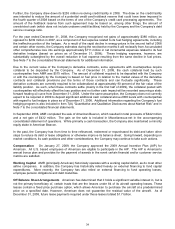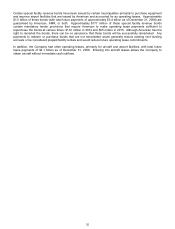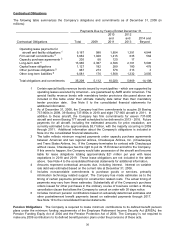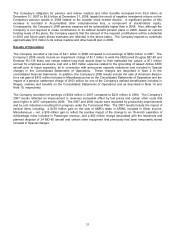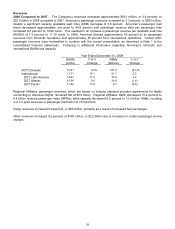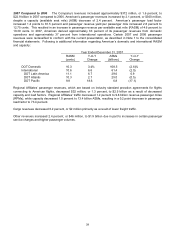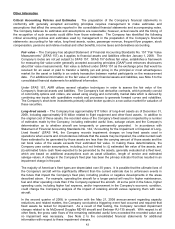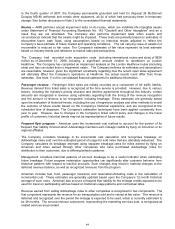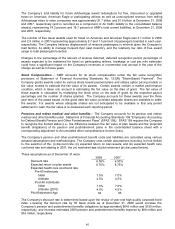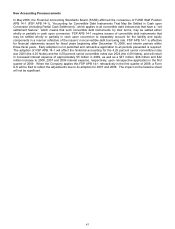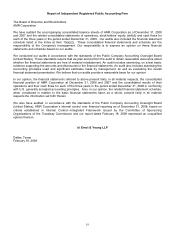American Airlines 2008 Annual Report Download - page 47
Download and view the complete annual report
Please find page 47 of the 2008 American Airlines annual report below. You can navigate through the pages in the report by either clicking on the pages listed below, or by using the keyword search tool below to find specific information within the annual report.44
In the fourth quarter of 2007, the Company permanently grounded and held for disposal 24 McDonnell
Douglas MD-80 airframes and certain other equipment, all 24 of which had previously been in temporary
storage. See further discussion in Note 2 to the consolidated financial statements.
Routes -- AMR performs annual impairment tests on its routes, which are indefinite life intangible assets
under Statement of Financial Accounting Standards No. 142 "Goodwill and Other Intangibles" and as a
result they are not amortized. The Company also performs impairment tests when events and
circumstances indicate that the assets might be impaired. These tests are primarily based on estimates of
discounted future cash flows, using assumptions based on historical results adjusted to reflect the
Company’s best estimate of future market and operating conditions. The net carrying value of assets not
recoverable is reduced to fair value. The Company's estimates of fair value represent its best estimate
based on industry trends and reference to market rates and transactions.
The Company had recorded route acquisition costs (including international routes and slots) of $828
million as of December 31, 2008, including a significant amount related to operations at London
Heathrow. The Company has completed an impairment analysis on the London Heathrow routes (including
slots) and has concluded that no impairment exists. The Company believes its estimates and assumptions
are reasonable; however, given the significant uncertainty regarding how the recent open skies agreement
will ultimately affect the Company’s operations at Heathrow, the actual results could differ from those
estimates. See Note 11 to the consolidated financial statements for additional information.
Passenger revenue – Passenger ticket sales are initially recorded as a component of Air traffic liability.
Revenue derived from ticket sales is recognized at the time service is provided. However, due to various
factors, including the industry’s pricing structure and interline agreements throughout the industry, certain
amounts are recognized in revenue using estimates regarding both the timing of the revenue recognition
and the amount of revenue to be recognized, including breakage. These estimates are generally based
upon the evaluation of historical trends, including the use of regression analysis and other methods to model
the outcome of future events based on the Company’s historical experience, and are recognized at the
scheduled time of departure. The Company’s estimation techniques have been applied consistently from
year to year. However, due to changes in the Company’s ticket refund policy and changes in the travel
profile of customers, historical trends may not be representative of future results.
Frequent flyer program – American uses the incremental cost method to account for the portion of its
frequent flyer liability incurred when AAdvantage members earn mileage credits by flying on American or its
regional affiliates.
The Company considers breakage in its incremental cost calculation and recognizes breakage on
AAdvantage miles sold over the estimated period of usage for sold miles that are ultimately redeemed. The
Company calculates its breakage estimate using separate breakage rates for miles earned by flying on
American and miles earned through other companies who have purchased AAdvantage miles for
distribution to their customers, due to differing behavior patterns.
Management considers historical patterns of account breakage to be a useful indicator when estimating
future breakage. Future program redemption opportunities can significantly alter customer behavior from
historical patterns with respect to inactive accounts. Such changes may result in material changes to the
deferred revenue balance, as well as recognized revenues from the program.
American includes fuel, food, passenger insurance and reservations/ticketing costs in the calculation of
incremental cost. These estimates are generally updated based upon the Company’s 12-month historical
average of such costs. American also accrues a frequent flyer liability for the mileage credits expected to be
used for travel on participating airlines based on historical usage patterns and contractual rates.
Revenue earned from selling AAdvantage miles to other companies is recognized in two components. The
first component represents the revenue for air transportation sold and is valued at fair value. This revenue is
deferred and recognized over the period the mileage is expected to be used, which is currently estimated to
be 28 months. The second revenue component, representing the marketing services sold, is recognized as
related services are provided.


